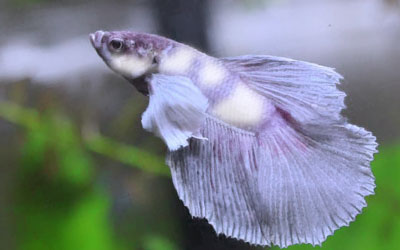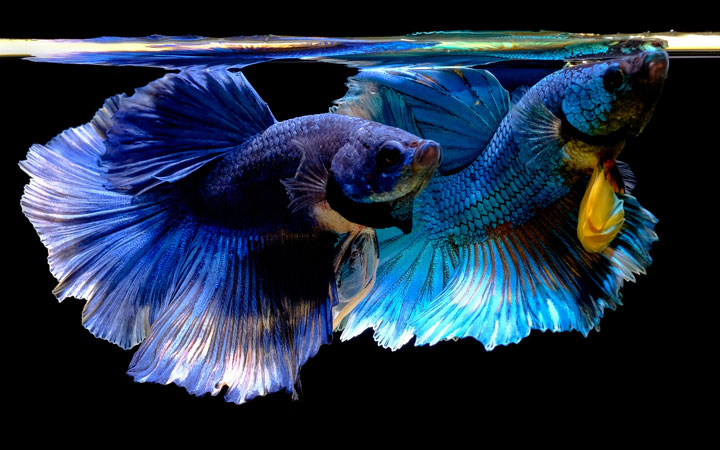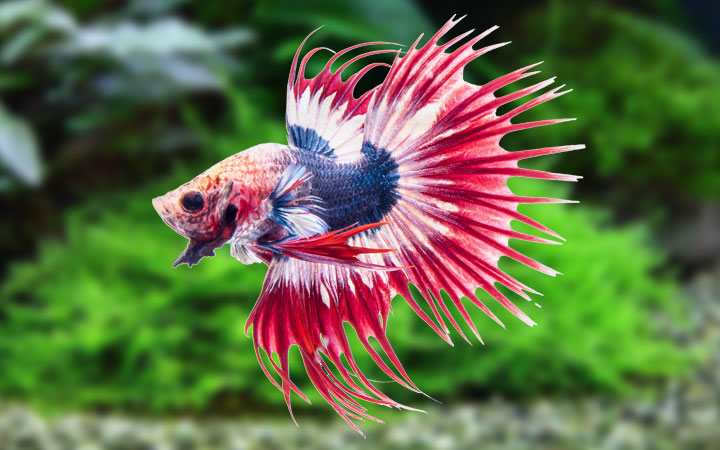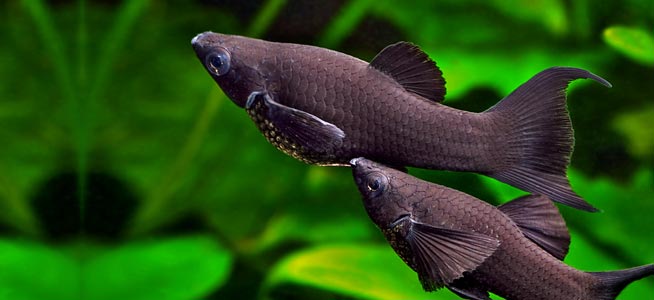Gouramis are a unique freshwater fish, often known for their flat, oval-shaped bodies and whisker-like feeler fins. As a type of anabantoid or labyrinth fish, they have a special labyrinth organ that acts like rudimentary air, allowing them to gulp oxygen from the surface and create bubble nests for breeding. Gouramis sometimes get a bad reputation for being ornery, so we found our top 5 peaceful gouramis that play nice with other community fish.
1. Female Powder Blue Gourami
Dwarf gouramis (Trichogaster lalius) are one of the most popular gouramis you see at pet stores. Despite their small size, male can be quite feisty and may end up bullying their fellow tank mates. Females are much calmer by nature, but most of them are duller in color. Luckily, female powder blue gouramis look just as stunning as their male counterparts without the attitude problems. You can keep this 3-inch (7.5 cm) fish by herself or in a group of girls. To contrast with their beautiful blue scales, try adding some orange schooling fish like lambchop rasboras or ember tetras. As with most smaller gouramis, they will eat just about anything a betta fish does, such as floating betta pellets, insect-based granules, and more.

Female gouramis tend to have a rounded tip on their dorsal fin and a larger body size compared to males.
2. Pearl Gourami
Hailing from southeast Asia, Trichopodus leerii is the largest species on our list that grows up to 5 inches (13 cm) in length. Because of their bigger size, you can keep one in a 29-gallon tank or a group of them in a 55- or 75-gallon aquarium. Their light brown body is covered in white dots or “pearls” with a black horizontal line running down the side, and males display a bright red-orange throat and belly during courtship. Compared to other gouramis, they have especially long and thin modified ventral fins that act like whiskers to help them explore their environment. Pearl gouramis are not picky eaters and will readily consume an omnivore diet of freeze-dried foods, Hikari Vibra Bites, and floating pellets.

Pearl gouramis are instantly recognizable by their spotted pearls and long ventral fins.
3. Chocolate Gourami
Looking for a rarer species to add to your collection? Sphaerichthys osphromenoides is a 2.5-inch (6 cm) gourami with a dark chocolate brown body that’s shaped like a leaf and overlaid with vertical, golden stripes. Because the fish are usually wild-caught, they can be picky eaters initially that only take live and frozen foods, but with enough patience, hobbyists have successfully converted them to eating crushed flakes and micro pellets. In Indonesia and the surrounding regions, they come from waters with low pH, low GH (general hardness), and gentle flow. To truly appreciate these peaceful, laidback gouramis, add lots of live aquarium plants and shaded places to hide so that they feel comfortable in their new surroundings.

Chocolate gouramis can be a little delicate when you first buy them, so pamper them with a stress-free environment to increase their health and immunity.
4. Sparkling Gourami
Coming in at 1.5 inches (4 cm) long, Trichopsis pumila (also known as the pygmy gourami or dwarf croaking gourami) is the smallest species on our list. They are one of the few fish that can make an audible sound that comes from twitching their modified pectoral fins and can be heard “croaking” during sparring or courtship. Sparkling gouramis have bright blue eyes and a body with brown, dotted striping and iridescent blue spangling. Keep these miniature gouramis by themselves, in pairs, or in a small group with other peaceful, nano fish. You can feed them anything small enough to fit in their mouths, like daphnia, baby brine shrimp, and fine granules.

Sparkling gouramis are excellent micropredators that will happily eat up all the seed shrimp, detritus worms, and even hydra in your fish tank.
5. Honey Gourami
The super peaceful Trichogaster chuna is native to India and Bangladesh, and several color variants have been produced, such as wild type, yellow-gold, and red. As with most gouramis, the males tend to be more colorful than the females. Both sexes are equally good-natured and can live as a single, pair, or group with similarly sized community fish. They really stand out in a lushy planted aquarium with schooling fish of a different color, like green neon tetras. Honey gouramis are also fun and easy to breed, where the male builds a bubble nest to protect the fertilized eggs until they hatch.

Honey gouramis are mostly solid-colored, but males often develop a dark blue-black throat and abdomen during breeding periods.
Honorable Mention: Paradise Fish
Macropodus opercularis is a famous gourami from East Asia and is historically labeled as one of the first tropical freshwater fish kept in a home aquarium (besides pond fish like carp and goldfish). It can grow to 2.5-3 inches (6-8 cm) long and comes in normal, albino, and solid blue versions. The “normal” type features a forked tail and striking blue and red-orange vertical stripes. Paradise fish are extremely hardy and can live in a temperature range from 61-80°F (16-27°C), which means you can keep them in an unheated aquarium of 20 gallons or larger.

Paradise fish have several nicknames, including “paradise gourami” and “Chinese fighting fish.”
The reason why this beautiful fish gets an honorable mention is because they are considered semi-aggressive like betta fish, where the males like to squabble over territory. However, like betta fish, they can be kept in a community tank if given the right tank mates. Avoid adding other anabantoids (e.g., bettas and other gouramis), slow-moving fish, or fish with long fins. Instead, we recommend faster, larger schooling fish like giant danios and barbs, as well as bottom dwellers like catfish and loaches. If you are interested in a cheap, centerpiece fish with a bold personality, you have to try the paradise gourami.






















:max_bytes(150000):strip_icc():format(webp)/common-new-aquarium-mistakes-1380712_FINAL-5c769a8146e0fb0001a982ca.png)

